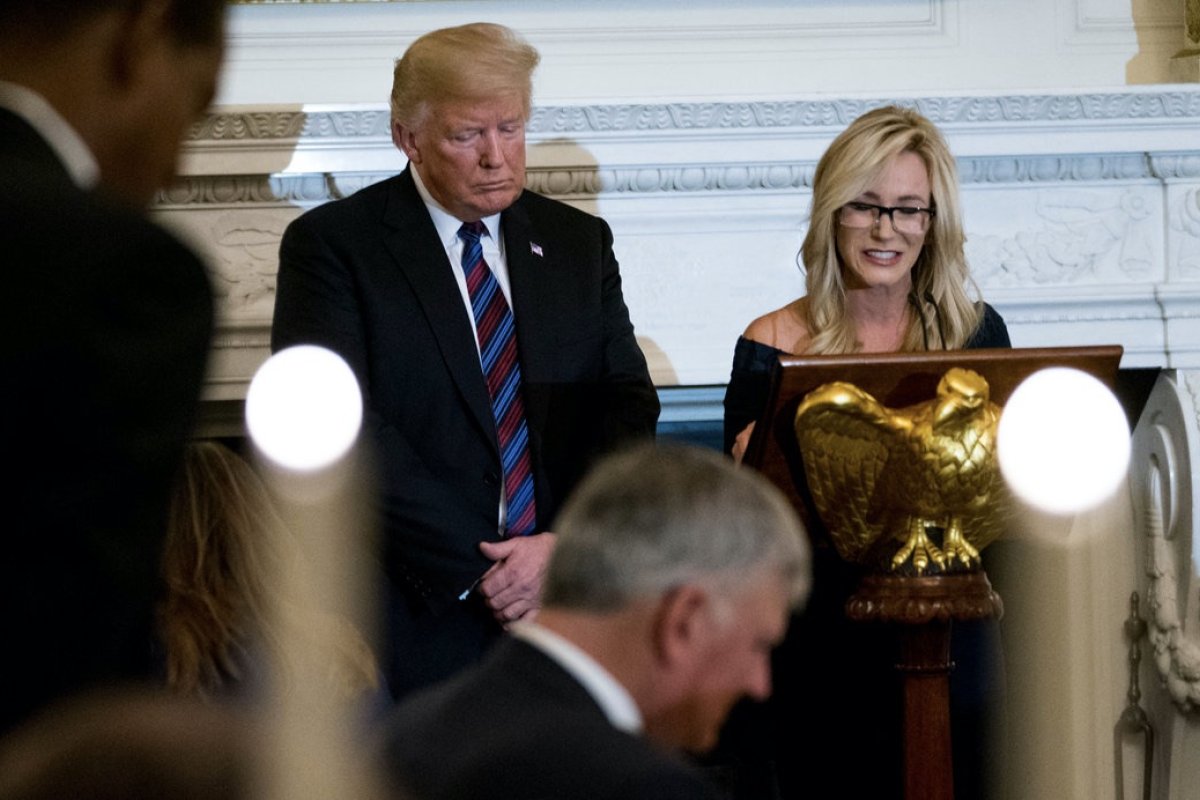
Paula White and the Mainstreaming of American Pentecostalism
Trump's appointment of Paula White is an indicator of shifting lines within the Christian right
This past week, Paula White, televangelist and personal pastor to President Trump, was picked to head the White House’s Faith and Opportunity Initiative, a unit in the Office of Public Liaison tasked with outreach to religious groups. For close observers of the Trump Administration, this move was hardly a surprise. Paula White is not only a frequent visitor to the White House but a confidant of the president. She was in attendance—and mentioned by name—when President Trump announced the creation of the Faith and Opportunity Initiative more than a year ago. White’s long relationship with Trump, which began in 2003, and her central role in his 2016 campaign as chairman of his Faith Advisory Board, were enough to overcome her lack of previous government service and her polarizing reputation in religious circles…
And her Pentecostalism.
Seeing Trump’s support of White solely as a new high watermark in their fifteen-year relationship ignores what White’s ascension in American public life teaches us about American religion, namely the mainstreaming of Pentecostal Christians among the Christian right. Rewind time a few decades—back to the 1970s should be far enough—and we see that the theological and historical lines dividing various subcultures in conservative Protestantism (including charismatics, Pentecostals, evangelicals, and fundamentalists) had real political consequences. As historian Neil J. Young recounts in his history of the religious right and interfaith politics, as late as 1982 a meeting of evangelical and fundamentalist political leaders contemplated if including Pentecostals into their upper ranks was “too much to expect.” Of course, there were already Pentecostal or charismatic leaders in the Christian right, but the evangelical-fundamentalist “truce,” in Young’s words, that helped create the Christian right made these two communities the movement’s gatekeepers.
Before situating Paula White in the more recent Pentecostal-friendly Christian right, it is important to acknowledge the historical reality that Pentecostals were at one time marginalized in the broader Protestant world (and still are in some places). The distinguishing theological mark in Pentecostalism is the prominent role it gives to the Holy Spirit, the third person of the Trinity. Speaking in tongues, baptism by the spirit, miraculous healings, and supernatural blessings of wealth are all variations on Pentecostal teachings on the Holy Spirit (charismatic Christians share these beliefs, but they are distinguished by their membership in non-Pentecostal denominations). Because they were shunned not only by mainline denominations but also by evangelicals and fundamentalists, who regarded speaking in tongues and related practices as deviant, Pentecostals have a distinct history that has afforded more opportunities for women leaders, from Aimee Semple McPherson to Kathryn Kuhlmann to Paula White herself.
Within the Christian right of the 1980s, the sense of evangelical-fundamentalist elitism faded, in many ways coinciding with the collapse of Jerry Falwell’s Moral Majority (which finally disbanded in 1989). The year before, charismatic Pat Robertson had run for president—one sign of rising theological diversity among the Christian right’s leadership, though he had failed to garner a majority of evangelical-fundamentalist voters. But as Robertson turned his presidential run into a longer-term political operation, which became the Christian Coalition (a type of successor grassroots organization to Moral Majority in the 1990s), the shift toward Pentecostal recognition in the Christian right was well underway. In major areas of conservative evangelical politics, from pro-Israel lobbying to free-market economics, Pentecostals have become central and public drivers of activism.
Of course, the story of overlapping political interests dissolving theological barriers is not new. Sociologist Robert Wuthnow famously wrote in 1988 about The Restructuring of American Religion along these lines, and books by Grant Wacker, Molly Worthen, Daniel Williams, and many other historians have shown the same process. Francis Fitzgerald, in her recent political history of evangelicalism, documents how a new class of Christian right leaders emerged in the 1990s and 2000s—leaders who were as comfortable in the halls of political power as they were in pulpits. Having come of age after the rise of the Christian right of the 1970s, and having never known of an era of American politics that did not refer to evangelicals as a political demographic, this new breed of Christian right leader was defined far less by theology than by ideology. Paula White’s ascension to Trump’s inner circle, and now her official position in the White House, is a dual testament to this historical process: to the ongoing mainstreaming of Pentecostalism in the broader culture of “evangelical politics,” and to the historically-contingent de-emphasis of labels like Pentecostalism in shaping American political coalitions at all.
Image: Paula White, who was recently appointed by President Trump to a formal role in the administration with the Public Liaison office, leads a prayer for evangelical leaders in the State Dining Room of the White House in 2018. (Photo: Alex Brandon | AP)
Sightings is edited by Joel Brown, a PhD Candidate in Religions in the Americas at the Divinity School. Sign up here to receive Sightings via email. You can also follow us on Facebook and Twitter. The views and opinions expressed in this article are those of the author and do not necessarily reflect the position of the Marty Center or its editor.


